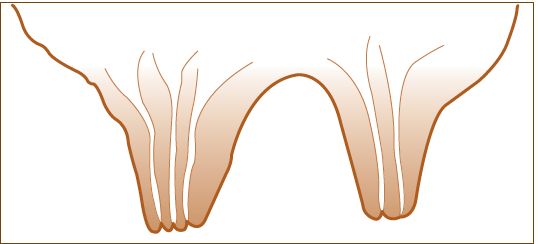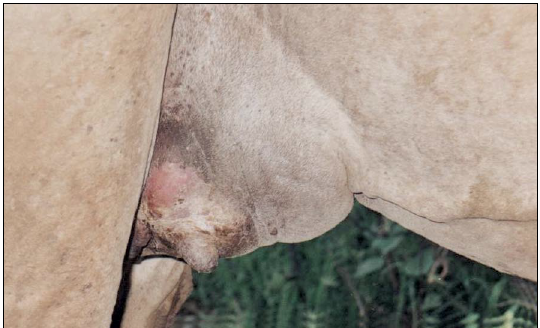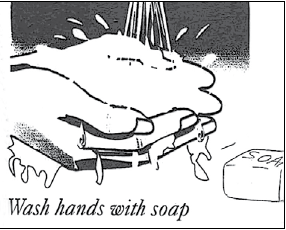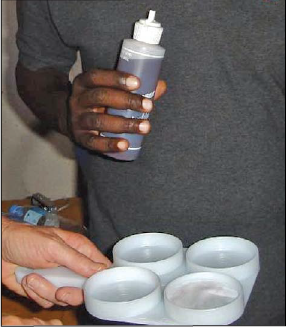
Camel udders differ from all other known milk producing animals in that they have 2 or more milk canals in every teat. This is probably another adaptation to their environment – even if one gets spoiled there are still others to produce milk for the calf. It does pose a challenge in the control of mastitis, as the methods for mastitis control in cows cannot be used for camels.
Zoonosis
Zoonotic diseases like brucellosis and tuberculosis can be spread to humans through milk. For camels brucellosis transmission to humans is probably the biggest problem.
Mastitis
Mastitis is the name for the inflammation of one or more milk canals and the udder of milk producing mammals.

Mastitis symptoms in high yielding camel (note large milk vein). The quarter has become hard and hot to the touch, and a red swelling has appeared. The camel may kick excessively as the quarter has become painful to the touch.
Mastitis is common in all pastoral areas, and camels are as badly affected as goats and cows. Good milkers who know about mastitis, will milk healthy animals first and affected animals last to avoid carrying the disease to healthy animals.
The main cause of mastitis is dirt – unclean milker hands, dirty animal beddings, manure getting into contact with the udder, flies, etc. North American and European farmers have shown that is possible to boost animal immune systems against mastitis with a combination of good feeding practices and very good hygiene and culling of susceptible animals to completely avoid mastitis in cows, but it takes a great effort. Some research is currently ongoing, so camel mastitis will eventually be better documented.
Another factor that predispose to mastitis is traumatic injury (wounds). This can be caused by poor milking technique, ticks or any other wounds such as thorn scratches.
Mastitis not only reduces the milk yield of the lactating animal, sometimes whole quarters of udders dry up – it also negatively affects milk quality, taste and keeping time. A small addition of mastitic milk to any can of milk will make it acquire a very bitter taste, which can not be removed by boiling. Mastitis bacteria live off the fat of the milk and produce toxins (poisons) which can cause food poisoning, sore throats, etc.
Many types of germs can cause mastitis including Staphylococcusaureus which also causes hair loss and rough coat on especially camels. So it is not a good idea to wipe hands on the coat of the camel before or after milking.
Whereas there are medicines for the treatment of mastitis in cows, such as ready made syringes containing various antibiotics, this remedy is NOT POSSIBLE FOR CAMELS AND GOATS. Both camels and goats have much narrower milk canals than cattle and trying to insert a cow syringe in any of their udders will cause a lot of damage in the milk canal. There is no space for it.
Before the arrival of antibiotics, mastitis could sometimes be cured by very frequent milking of the affected quarter. But this would include milking every hour even during the night until the temperature goes down in the quarter and the milk returns to normal, which is quite an undertaking. If the camel has wounds on the udder, stripping technique of milking should be discouraged and use of milking salve be encouraged especially for camels which are not suckling calves.
In camels, an early infection can at times be cured by giving the calf to the affected animal and avoid milking by human hands.

If this is not possible, care should be taken to milk the affected animal(s) last in order not to carry the disease to a healthy animal.
Care should be taken to Not Mix mastitic milk with clean milk. Always wash hands between milking every animal.

between milking every animal
Testing for Mastitis
Mastitis symptoms (such as clotting of milk) is only visible in camel milk in very advanced stages. Early stages can be suspected if the camel kicks too much when one or more teats are touched, the udder is hot and the skin over the quarter seems tight even after milking.
Using CMT: California Mastitis Test kit. This consists of a small plastic tray with 4 bowls and a handle and a solution of detergent. Generally it may be a good idea to imagine the handle of the tray represent the TAIL of the animal, and look at the different quarters separately from there.

Follow instructions in the manual to identify even hidden mastitis. In pastoral herds in Kenya, often more than 50 % of animals are infected by mastitis in one or more quarters. A small amount of the the first milk stripped is mixed with a similar amount of test chemical, the mixture swirled around and if mastitis is present, the mixture becomes thick and slimy. Non-infected milk stays liquid.
Alcoholtest:
2 ml milk is mixed with 2 ml alcohol (65%) and poured into a transparent glass. Twirl it to spread over the side of the glass. If separation is seen the milk can either be mastitic or acidic.
One of the routine tests for mastitis is strip cup

But any black surface can serve the purpose. In rural areas, some individuals have been known to use black paper bag wrapped over a cup. This will identify advanced stages of camel mastitis, but is less useful for early cases, when action needs to be taken.